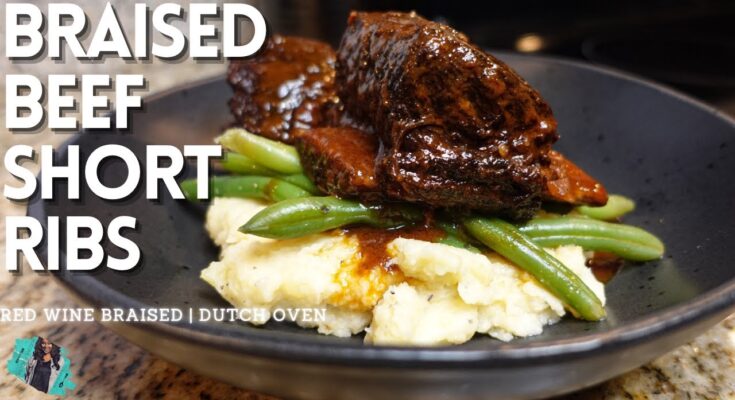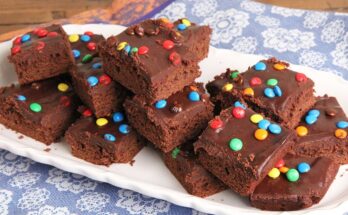Boneless Beef Short Ribs Recipe: Boneless beef short ribs might not get the fame of their bone-in counterparts, but they’re a juicy, flavorful powerhouse when cooked the right way. These meaty cuts come from the chuck area and pack all the beefy goodness you’d expect—just without the bones. That means more meat per bite, and let’s be real—who doesn’t love that?
Perfect for a cozy dinner or impressing guests, boneless beef short ribs are incredibly versatile. Whether you’re going for rich and savory braised ribs or looking to throw something hearty in the slow cooker, you’ll find they’re both easy to cook and totally worth the effort.
Why Choose Boneless Beef Short Ribs?
There’s a good reason these ribs are getting all the hype lately. First off, boneless short ribs are easier to handle—no bones, no fuss. They’re ideal for home cooks who want maximum meat with minimal prep drama. Plus, they cook a bit faster than bone-in cuts and absorb marinades and flavors more easily.
But the real reason to choose them? That unbeatable texture and richness. When slow-cooked or braised just right, they become melt-in-your-mouth tender with a deep, savory flavor that’s hard to beat. Whether you’re throwing them into a red wine braise, slow-cooking with soy and garlic, or oven-roasting with rosemary, these ribs never disappoint.
Key Ingredients You’ll Need
Primary Ingredients
Let’s start with the basics. Here’s what you’ll need for the foundation of your dish:
- 2 to 3 lbs boneless beef short ribs (cut into 2-inch pieces)
- 2 tbsp vegetable oil (for searing)
- 1 large onion, sliced
- 4 garlic cloves, minced
- 2 cups beef broth
- 1 cup red wine (optional but adds depth)
- 2 tbsp tomato paste
You can always add carrots, celery, or mushrooms if you want to toss in some vegetables for extra heartiness.
Seasonings and Marinade
Here’s where the magic happens. A well-seasoned rib can make all the difference:
- Salt and pepper, to taste
- 1 tsp smoked paprika
- 1 tsp dried thyme
- 1 bay leaf
- 1 tbsp Worcestershire sauce
- Fresh parsley (for garnish)
Feel free to customize the seasoning. Want it spicier? Add chili flakes. Looking for an Asian twist? Swap in soy sauce, ginger, and a touch of brown sugar.
Kitchen Tools & Equipment
Before you get cooking, make sure your kitchen is armed and ready. Here’s what you’ll need:
- Heavy-bottomed skillet or Dutch oven (for searing and braising)
- Tongs (for flipping ribs)
- Sharp knife and cutting board
- Measuring spoons and cups
- Foil or a lid (if using an oven-safe dish)
- Slow cooker or Instant Pot (if you’re going that route)
Having the right tools makes this process smoother, quicker, and frankly, more enjoyable. Trust me, once you sear meat in a good Dutch oven, there’s no going back.
Prepping the Boneless Short Ribs
Prep is everything when it comes to making your short ribs sing. Start by patting the ribs dry with a paper towel—this helps them sear properly instead of steaming. Once dry, season them generously with salt, pepper, and your choice of dry rub.
Next, if you have time, marinate your ribs for at least an hour, or ideally overnight in the fridge. A simple marinade of soy sauce, garlic, red wine, and olive oil works wonders. This step isn’t mandatory, but it deepens the flavor and tenderizes the meat beautifully.
Then, chop your onions, mince your garlic, and measure out your liquids. Having everything ready before you turn on the stove saves you from last-minute scrambling and burnt garlic nightmares.
Step-by-Step Cooking Instructions
Mastering boneless beef short ribs means nailing the cooking process. Here’s a foolproof step-by-step guide to get those ribs tender, juicy, and packed with flavor.
Searing the Ribs
First things first—searing. This step is crucial for building flavor. Heat about 2 tablespoons of vegetable oil in a heavy-bottomed skillet or Dutch oven over medium-high heat. Once the oil is shimmering, add the ribs in batches. Don’t overcrowd the pan—each rib needs direct contact with the hot surface.
Sear each side for about 2-3 minutes until a rich, golden-brown crust forms. This not only locks in the juices but also creates that deep umami flavor foundation that makes braised ribs so irresistible. After searing, set the ribs aside on a plate.
Braising Process
After searing, reduce the heat to medium and toss in your onions. Sauté for 5 minutes until translucent, then add minced garlic and tomato paste. Stir for about a minute to let the flavors bloom. Deglaze the pan with red wine (or more broth if skipping wine), scraping up the browned bits from the bottom.
Once your liquid has reduced slightly, add the beef broth, Worcestershire sauce, thyme, bay leaf, and paprika. Stir well. Now, nestle the seared ribs back into the pot, making sure they’re mostly submerged.
Cover tightly and either:
- Simmer on the stove for 2.5 to 3 hours on low heat, or
- Transfer to a 325°F (160°C) oven for the same amount of time.
Check every hour to ensure the liquid hasn’t reduced too much. Add a splash of water or broth if needed.
Oven vs. Slow Cooker – What’s Best?
Choosing between the oven and the slow cooker depends on your lifestyle. The oven is great for even, consistent heat and gives the ribs a slightly more concentrated flavor. But the slow cooker? It’s a set-it-and-forget-it kind of magic.
- Oven: Perfect if you have the time and want a slightly roasted, caramelized edge on your ribs. Ideal for dinner parties.
- Slow Cooker: Great for busy days. Just sear the ribs and toss everything in. Cook on low for 7-8 hours or high for 4-5. The meat falls apart like butter.
Either method will yield dreamy results, but if you’re into hands-off cooking with less babysitting, the slow cooker is your best friend.
How to Tell When Your Ribs Are Done
Don’t just rely on the clock—your ribs will tell you when they’re ready. Look for these signs:
- Tenderness: You should be able to shred the meat easily with a fork. If you have to tug or cut, they need more time.
- Juiciness: The meat will be juicy but not swimming in fat. A slight pull of the fork should show tender, moist fibers.
- Color: They’ll be deep brown with a glossy finish from the braising liquid.
If you’re using a thermometer, the internal temp should be around 195°F to 205°F (90°C–96°C) for that fall-apart texture.
Serving Suggestions
Now comes the fun part—serving up your culinary masterpiece. Here are some pairing ideas to complement your ribs:
- Mashed Potatoes: Creamy, buttery, and the perfect base to soak up that savory sauce.
- Polenta: Smooth, cheesy polenta gives a nice contrast in texture.
- Crusty Bread: To mop up every drop of that rich braising liquid.
- Roasted Vegetables: Carrots, parsnips, or Brussels sprouts roasted with olive oil and herbs.
- Rice or Egg Noodles: Perfect for catching all that gravy.
Don’t forget a fresh garnish—chopped parsley or green onions give a nice pop of color and freshness.
Storing and Reheating Leftovers
Boneless beef short ribs are just as delicious the next day—maybe even more. The flavors continue to develop, making leftovers a treat.
Storage Tips:
- Cool completely before storing.
- Keep in an airtight container.
- Refrigerate for up to 4 days or freeze for up to 3 months.
Reheating:
- Gently warm in a covered pan over low heat with a splash of broth.
- In the oven, reheat at 300°F (150°C) until hot (about 20–25 minutes).
- Microwave on medium power in 1-minute intervals, stirring occasionally.
Always reheat gently to maintain that juicy tenderness.
Common Mistakes to Avoid
Cooking boneless beef short ribs may seem straightforward, but a few missteps can turn tender bliss into a dry disappointment. Here are the most common mistakes to avoid:
1. Skipping the Sear
Don’t even think about tossing your ribs directly into the oven or slow cooker without searing first. Skipping this step means missing out on layers of deep, caramelized flavor. That crispy, browned exterior is pure magic—and it only takes a few minutes.
2. Not Giving It Enough Time
Rushing your ribs is a big no-no. These cuts are tough by nature and need a long, slow cook to break down the collagen and fat. Under-cooking leaves you with chewy, rubbery meat—not the melt-in-your-mouth experience you’re aiming for.
3. Too Little Liquid
During braising, liquid is your best friend. You don’t need to drown your ribs, but they should be mostly submerged to prevent drying out. Always check the pot halfway through to ensure you’re not running low.
4. Using the Wrong Cut
Make sure you’re actually using boneless beef short ribs—not just any chuck meat. The marbling and texture of short ribs are key to achieving that signature tenderness and flavor.
5. Overcrowding the Pan
When searing, give each rib its space. Crowding causes steam, not sear. Work in batches so every rib gets the love it deserves.
Nutritional Information
If you’re curious about the health side of things, boneless beef short ribs are hearty—but not without calories. Here’s a general breakdown per serving (about 6 oz cooked):
| Nutrient | Amount |
|---|---|
| Calories | 400–450 kcal |
| Protein | 30–35g |
| Fat | 30–35g |
| Saturated Fat | 12–15g |
| Carbohydrates | 5–10g (with sauce) |
| Fiber | 0–2g |
| Sodium | 400–600mg |
Of course, this varies depending on your specific ingredients and portion size. You can reduce fat by trimming excess before cooking and using leaner broth or less oil.
Tips for Extra Tender Ribs
Want ribs that practically melt off your fork? Try these next-level tips to take your dish to legendary status:
- Marinate Overnight: A marinade with acid (like vinegar or wine) and salt helps break down muscle fibers in advance.
- Use Low and Slow Heat: Keep your temperature between 275°F–325°F for optimal breakdown of collagen.
- Let It Rest: After cooking, let the ribs sit covered for at least 10-15 minutes. This lets the juices redistribute evenly.
- Don’t Rush the Sear: Browning properly means developing that savory crust, which locks in flavor and moisture.
- Add a Touch of Sweetness: A little honey, brown sugar, or balsamic can balance the rich, savory notes and give a beautiful glaze.
FAQs About Boneless Beef Short Ribs Recipe
Q1: What are boneless beef short ribs?
A: Boneless beef short ribs are a flavorful cut of meat taken from the chuck or plate section of the cow. They’re known for their rich marbling and become melt-in-your-mouth tender when slow-cooked or braised.
Q2: How long does it take to cook boneless short ribs?
A: Typically, boneless short ribs take about 2.5 to 3 hours to become fork-tender in the oven at 325°F (163°C). For slow cookers, expect 6–8 hours on low.
Q3: Can I cook them in a pressure cooker or Instant Pot?
A: Absolutely! Pressure cooking takes about 45–60 minutes on high pressure, followed by a natural release for best results.
Q4: Should I sear boneless short ribs before cooking?
A: Yes! Searing locks in flavor and adds a rich, caramelized crust that takes the dish to the next level.
Q5: What’s the best way to season boneless short ribs?
A: A simple rub of salt, pepper, garlic powder, and a touch of smoked paprika works wonders. For a deeper flavor, marinate overnight in red wine, soy sauce, or balsamic vinegar blends.
Q6: Can I make them ahead of time?
A: Yes, and they taste even better the next day! Just reheat gently in the oven or stovetop with a splash of broth or sauce to keep them moist.
Q7: What should I serve with boneless short ribs?
A: Mashed potatoes, creamy polenta, roasted veggies, or crusty bread all pair beautifully with this hearty dish.
Final Thoughts
Boneless beef short ribs are one of those comfort foods that never go out of style. Whether you’re braising them in a rich red wine sauce or slow-cooking with garlic and herbs, they promise deep flavor, tender texture, and plenty of culinary satisfaction. With the step-by-step guide above, you’re well on your way to mastering this meaty masterpiece.
Take your time, enjoy the process, and don’t be afraid to get creative with flavors. Trust your senses, and you’ll end up with a dish that tastes like it came from a five-star kitchen—only better, because it’s homemade.



